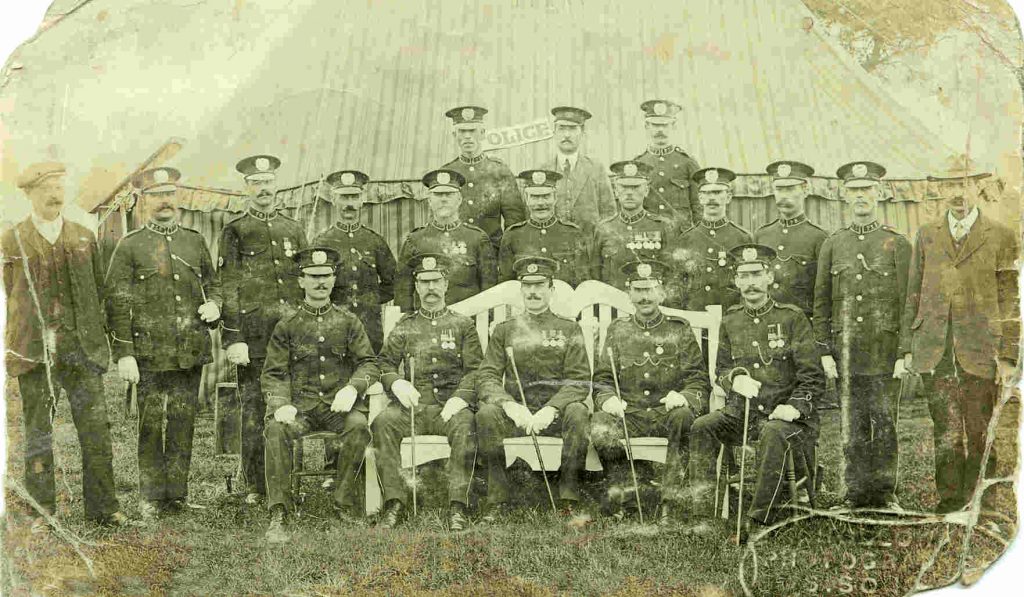Published on | #WeAre50, General
Guest Blog: Lindsey Ballinger
During the 19th and very early 20th century, the parks in Birmingham were patrolled by the Birmingham City Police. The parks were not always a safe place for families and in the 1880’s and 1890’s “several cases of indecent and immoral conduct” were reported, with a number of sexual assaults on both adults and children taking place in Calthorpe Park and Cannon Hill Park.
The parks were mainly used by Worcestershire ratepayers. The Parks Committee therefore applied to the Worcestershire Constabulary for additional police to help maintain law and order in the areas. Despite this, the Parks Committee still believed the number of police officers patrolling the parks was not enough to control disturbances “by certain classes”. This meant that park employees were often left to deal with difficult situations with the “rougher element” of society.

Birmingham City Police & Park Keepers
Ward End
1904
Birmingham Parks Police 1912 to 1963
In 1912, a dedicated Birmingham Parks Police force was established. This small team of dedicated officers was formed to police the parks and open spaces of Birmingham.
During the First World War, as with many occupations, women were appointed to the Parks Police, not only to replace those men who had been conscripted to fight in the War but also to help supervise children using the parks. After the War, more women were encouraged to join the Parks Police as even up to the 1950’s parks were still not considered safe places for youngsters to play, with regular reports of prosecutions for indecency towards children.

Birmingham Parks Police, Captains Badge
West Midlands Police Museum Collection
1930s
Birmingham Parks Rangers 1963 to 1969
On 1st April 1963, the Birmingham Parks Police were disbanded and a new force known as the Birmingham Parks Rangers were introduced. The new Rangers were dressed in a distinctive green uniform. The service had 84 Rangers and patrolled 406 parks and a number of golf courses and other Corporation properties.
The change was not popular as officers claimed that removing their “police” title would impact on their status and make their role more difficult. They also believed the change would lead to an increase in vandalism and inappropriate behaviour, despite reassurances that the provision of radios and vans would enable additional personnel to be sent in times of trouble. The Rangers were also expected to undertake gardening and labouring duties.
In November 1965, the Council rejected the Park Rangers’ request to reinstate their powers of arrest. The following month, a petition signed by over 400 people was presented to Birmingham City Council calling for the Rangers to be given back their police powers as the 70 strong force no longer commanded respect. They also asked for the police uniform to be reintroduced. By 1969, the number of Park Rangers had reduced to 49 and proposals were put forward to replace the Rangers with a new mobile patrol force

Birmingham Parks Police
C.1900s
Birmingham Parks Patrol 1969 to 1991
In June 1969, the Birmingham Park Rangers were replaced by the Birmingham Parks Patrol. Park Patrol Officers were attested as Park Constables and they were given the same powers and privileges as ordinary Police Constables. One of the biggest changes to the role was mobile patrolling. A new fleet of vans were provided, personal radios were issued and patrol dogs were introduced with training being given by Birmingham City Police.
The uniform was also changed from green to the more traditional police blue. A maroon cap band and epaulette made them distinguishable from Birmingham City Police Officers when travelling from park to park.
The Parks Patrol patrolled over 300 parks, open spaces and cemeteries and 92 other Parks Department properties – an area covering more than 9,500 acres. The City was split into three divisions – the south west was covered from Manor Farm Northfield, the south east from Cannon Hill Park and the north from Birchfield Depot. An Inspector was based at the Parks Department Headquarters to organise the patrolling and two Sergeants were placed at each division. Patrolling was conducted 365 days a year from 3pm to 11.59pm.
By the mid-1980’s the Parks Patrol had increased from an initial 20 officers to one Chief Inspector, three Inspectors, six Sergeants and 54 Constables (including two females).

Birmingham Parks Police
C. 1970s
Birmingham Parks Ranger Patrol 1991 to date
In 1991, the Birmingham Parks Force was again renamed, this time to the Birmingham Parks Ranger Patrol. The uniform changed back to green and was given a dramatic makeover, this time consisting of a ‘Nato’ style jumper, waterproof anorak and a cap.
By 2010, numbers had reduced dramatically to one Manager, three civilian Control Room Operators, two Sergeants and six Rangers, two of whom were dog handlers. By 2011, the control room had been replaced by mobile phones.
In 2018, the role of the service was to:
- Check security of buildings administered by the service
- Report accidents, incidents and security issues
- Maintain liaison with the police
- Liaise with council and police in respect of bye-law or criminal offences
- Report anti-social behaviour
- Provide an out-of-hours service for alarm activations and emergences occurring on parks department property.
Currently, the establishment consists of two Ranger Patrol Sergeants and four Patrol Officers. None of the Patrol Officers are attested and therefore they do not have the powers of a police officer. Their uniforms are also now the same colour as any other Birmingham City Council employee which is blue. Each officer is allocated a small white van.
Credit to Lindsey Ballinger, and the British Police History Website
